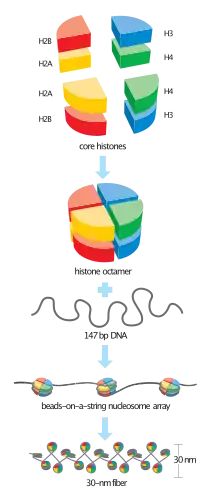Chromatosome
In molecular biology, a chromatosome is a result of histone H1 binding to a nucleosome, which contains a histone octamer and DNA.[1] The chromatosome contains 166 base pairs of DNA. 146 base pairs are from the DNA wrapped around the histone core of the nucleosome. The remaining 20 base pairs are from the DNA of histone H1 binding to the nucleosome.[2] Histone H1, and its other variants, are referred to as linker histones. Protruding from the linker histone are linker DNA. Chromatosomes are connected to each other when the linker DNA of one chromatosome binds to the linker histone of another chromatosome.[3]

Basic units of chromatin structure
References
- Bharath, M. M. Srinivas; Chandra, Nagasuma R.; Rao, M. R. S. (2003-07-15). "Molecular modeling of the chromatosome particle". Nucleic Acids Research. 31 (14): 4264–4274. doi:10.1093/nar/gkg481. ISSN 0305-1048. PMC 167642. PMID 12853645.
- Bednar, Jan; Dimitrov, Stefan (2011-07-01). "Chromatin under mechanical stress: from single 30 nm fibers to single nucleosomes". FEBS Journal. 278 (13): 2231–2243. doi:10.1111/j.1742-4658.2011.08153.x. ISSN 1742-4658. PMID 21535477.
- Widom, J. (1998). "Structure, dynamics, and function of chromatin in vitro". Annual Review of Biophysics and Biomolecular Structure. 27: 285–327. doi:10.1146/annurev.biophys.27.1.285. ISSN 1056-8700. PMID 9646870.
This article is issued from Wikipedia. The text is licensed under Creative Commons - Attribution - Sharealike. Additional terms may apply for the media files.